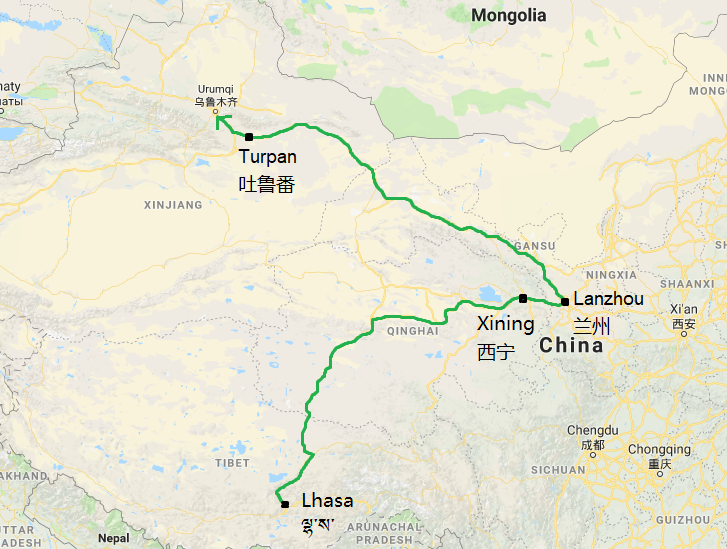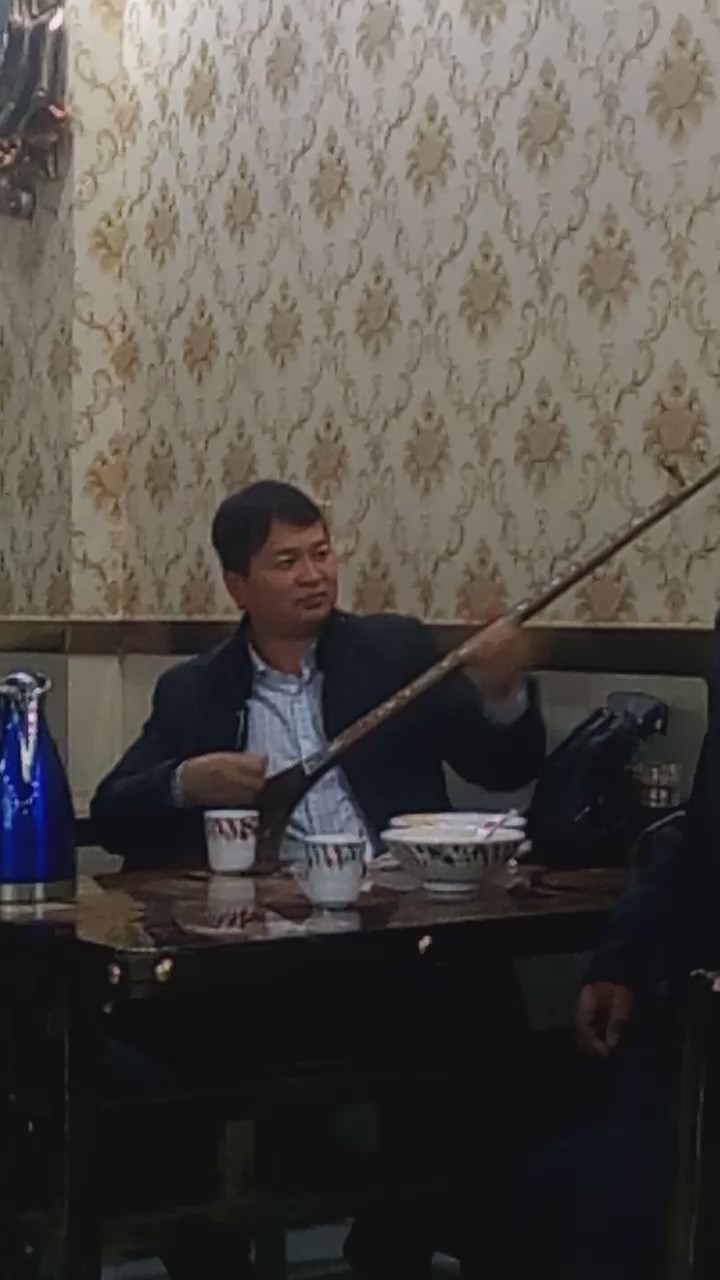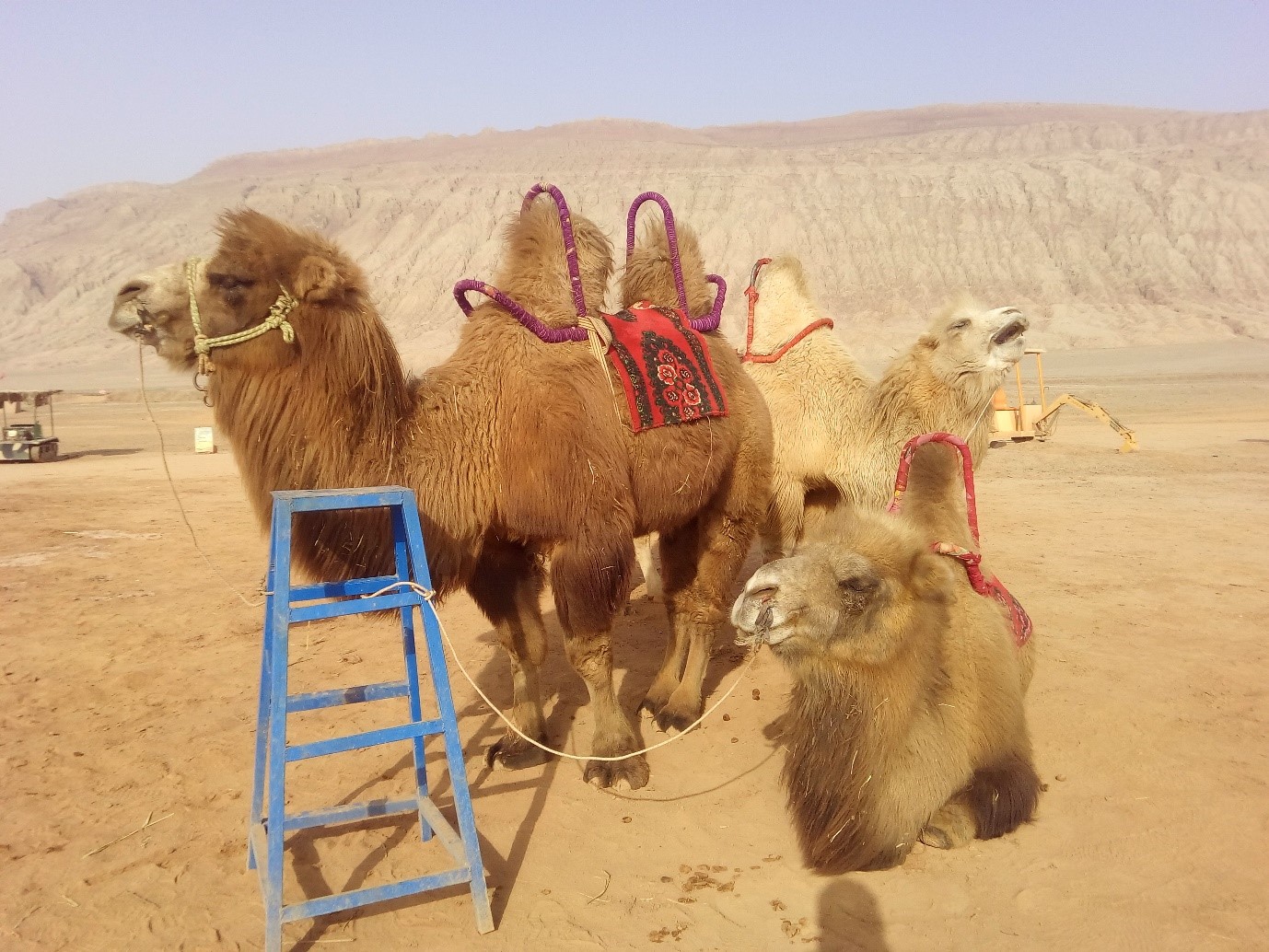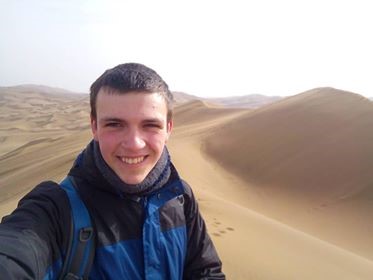Following the Silk Road
With the Tibet tour behind, it was time for two weeks of solo travel, starting in northwest China along the ancient Silk Road. The eastern half of China (where we live) contains 94% of the country’s population, so the west has a very different landscape to offer, far from the image of China most people have in their heads.

The first stop on the road was Xining. Chinese New Year was just around the corner, so train tickets were selling out fast. This meant my journey there unfortunately involved one night in a crowded hard seat carriage. It wasn’t too bad though, as I met interesting people on board: an 8-year old wanting to practise his English; a man who spoke Chinese with such a throaty accent that it sounded like Arabic; and a group of Tibetan monks, dressed in crimson robes and eating pot noodles.
Xining (27 January)
I only spent one evening in Xining, but it was enough time to get a taste of the city and visit the Dongguan Mosque, one of the largest mosques in China. Most Chinese people belong to an ethnic group called the Han, however many in Xining belong to the Hui ethnic group (pronounced “h-way”), who are traditionally Muslim. Several Tibetans also live in Xining, so I could see quite a variety of people on the city streets.

Dongguan Mosque
Lanzhou (28 January)
The next day I spent in the nearby city Lanzhou (pronounced “lan-joe”). Lanzhou is most famous for its special type of noodles called la mian; very thin, stretched by hand, served in a hot broth with beef and vegetables. Lanzhou noodles are popular all over China, and I often eat them for dinner in Tianjin. Having a bowl of authentic la mian for breakfast was a great way to start my day in Lanzhou.
I spent the afternoon walking along the Yellow River – the second longest in China – on which the city lies. Chinese families had come to play by the riverbanks, building sandcastles, flying kites, or simply taking a stroll. Seeing them reminded me of family trips to the seaside back home: nothing too fancy, just simple holidays to enjoy the fresh air and spend time with loved ones. A few parents asked to take photos of me with their children – being the only westerner around, it was hard to go unnoticed!

Lanzhou noodles (la mian)

The Yellow River
Urumqi (29 January)
After another night on the sleeper, I arrived in Urumqi, the capital of Xinjiang. Xinjiang is the largest province in China (over six times the size of the UK); it’s a vast region of mountains and deserts, and it particularly stands out because most of the people there don’t look Chinese. They belong to the Uyghur ethnic group (pronounced “wee-gur”), who are related to Central Asians and have their own language, culture and traditions.
I went to Xinjiang curious to learn about the Uyghur, however when I came out of Urumqi station – being the only tourist around, carrying two hefty rucksacks and spending an hour looking for a bus in -20⁰C – I started feeling a bit naïve. What’s more, I’d just seen photos of the other scholars on a beach in the Philippines – this didn’t particularly improve my mood!

A cold and frosty morning
My first stop was the Xinjiang Regional Museum, where I learned about the long history of trade along the Silk Road, and even saw some 4,000-year-old mummies from the area, surprisingly well preserved. I spent the rest of the day roaming the city on foot, searching for new sights and tastes.

The Grand Bazaar, Urumqi

Silk Road Mummy
One thing which struck me about Xinjiang was the high security: policemen patrolled nearly every street, metal detectors were placed over the entrances of restaurants, and I was often stopped to have my passport checked and photographed, even before entering a shopping mall. This is sadly due to the ongoing tension between the Uyghur and the Han Chinese. I never felt in danger at any point, but the added security gave the place a heavier, tenser atmosphere than anywhere I’d travelled before.
Another surprise was that although being the only foreigner around, I attracted very little attention from the locals. When I’ve been alone in Chinese-populated areas, I’ve often been the object of much curiosity. The Uyghur, on the other hand, didn’t seem to care.
Sometimes a stranger would ask me a question – “You are student?” “Yes.” “Good…” – then leave me alone, but little more than that.
I also learned that Urumqi is the most inland city in the world (furthest from any ocean). It seems my pursuit of a cultural experience really did take me as far away from the beach as possible!
Turpan (30 January – 2 February)
My next stop was the city of Turpan a few miles south – a smaller city with a few more interesting sights. The first day I visited the Emin Minaret, a mosque with a large tower made of sun-dried bricks. Surprisingly, this tourist site was pretty much in the middle of nowhere, surrounded by dusty vineyards without a person in sight. It felt nice being the only one around (almost like I had the mosque to myself), and the quiet atmosphere was unlike anywhere else I’d been in China. I also enjoyed walking through quiet, rustic neighbourhoods on my way there and seeing the local life: old men with long beards chatting at the roadside, women selling fruit and flatbread, and children playing football on the streets.

The Emin Minaret
That evening I had a bowl of lagman (beef noodle soup from Uzbekistan) for dinner at a local restaurant. After the customers had left, the chef and his friend took out a guitar and a dutar (two-stringed instrument from Iran) and had a small music session. I also made a local friend, who offered to show me around Turpan’s sights.

Uyghur man playing the dutar
Over the next two days he took me to the Flaming Mountains, where, according to legend, the Monkey King passed by on his journey from Xi’an to India (it’s also the hottest place in China during the summer); the Karez, a 2,000-year-old network of underground tunnels built for irrigating crops in the scorching weather (one of the greatest engineering projects of the ancient world); and the massive sand dunes of the Kumtag Desert. Travelling with a local made a big difference to my visit, as he could tell me what he knew about each place and about his own experience growing up in Xinjiang.
On my last night he took me to a Uyghur wedding, where we joined in the traditional dancing. I did a very poor job mimicking the moves of the dancers around me, however it was a great performance to watch – both young and old, men and women, joining in the dance with enthusiasm.

The Flaming Mountains

Going to the northwest of China wasn’t easy; spending days in places with a cold and tense atmosphere by myself. However, the experience of seeing such a region first-hand has left a significant, life-long mark. There’s still a lot of China I haven’t seen. Nevertheless, when I consider how the sand dune deserts, vineyards and folk dancers of Xinjiang differ from the futuristic megacity of Shanghai – or how the lush green lakes of Hangzhou differ from the mountain temples of Tibet or the icy, Russian streets of Harbin – I can see that China is far, far more than a country of pandas and noodles.
Soon it was time to leave the freezing winter of Xinjiang behind and head south for warmer, sunnier skies…